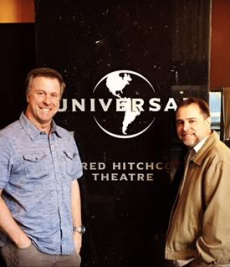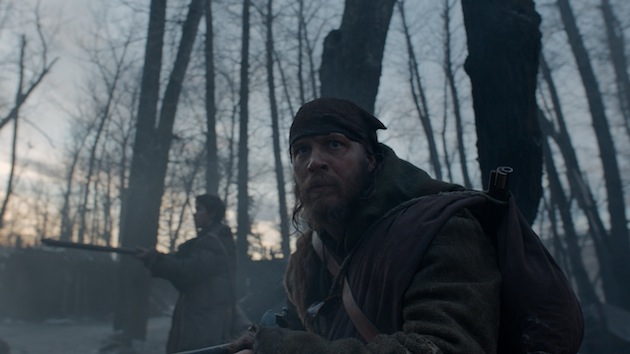
An Expansive, Immersive Soundscape for an Unpredictable Wilderness Odyssey
"We were just making a lot of noise down in the theater," Frankie Montaño says via speakerphone on the NBCUniversal movie lot where he and Jon Taylor had mixed The Revenant, Alejandro G. Iñárritu's multi-Oscar-nominated film. Their current project, The Huntsman Winter's War, a fairy-tale action thriller due out in April, shares only the thinnest, trackable link with The Revenant, which the re-recording mixers say was unlike anything they had ever done — even with Iñárritu.
The pair also worked together on Birdman there inside the lot's historic Alfred Hitchcock Theatre, where Montaño has been based for the past 16 years; Taylor began mixing for Iñárritu on 21 Grams and joined NBCUniversal's StudioPost team in 2013. Along with Supervising Sound Editor Randy Thom (the mixer behind that bear scene) and Chris Duesterdiek, The Revenant's mixing team has already won a BAFTA for Best Sound Mixing, earned the same honor from the Cinema Audio Society last weekend (with Conrad Hensel, Michael Miller and Geordy Sincavage), and are up for an Oscar this Sunday.
Sonically, they say, Birdman was an exercise in down-the-rabbit-hole control: confined, fluid and percussively constant, methodically building to escape its physical and emotional boundaries. The Revenant flipped that approach on its head. This film is immersive in a different way, moving through expansive and wildly unpredictable space, a place distantly foreign to modern ears raised on high-octane, symphonic cinema. And because of the way it was recorded on location in the remote wilderness, the pair say it was harder — but ultimately more rewarding — working with Iñárritu to merge the organic and layered final mix with his images.
"At times, he would literally orchestrate me," Taylor says, explaining how Iñárritu would physically wave his hands like a conducter to indicate where and how he wanted natural sounds to seep up through the music. "He's a very emotional director in the sense that for him, each scene and sound has to have an effect on the audience emotionally," adds Montaño. "There are moments when it has to be precise and clear, and there are times when it needs to have muscle and weight, or maybe [it] is blurry, to a degree. We always have multiple looks at each scene, each reel. We're never truly finished until Alejandro feels we've, as he puts it, exercised everything available to us and it has the right feel. Reshaping after reshaping, new ideas, new sounds. It all went into this project."
"There were always changes, but he lets us always start where we want to," says Taylor. "Then he comes in and says, 'All right, that's good, that's very good. Let's change it. It's too soft — I need it to hit me in the chest,'" Taylor says, giving a dead-on impression of his beloved director. "Or, 'Guys, guys, guys—it's too much! Let's give ourselves a break. But … I still want to know there's fear.' Then he'll let us find out way again. It's only when we get closer that he'll pinpoint things and be very specific. He always made time for us and was always here."
"Think haunting, elegant, aggressive," Iñárritu told them when they first planned their approach. "Haunting, meaning that you should never should feel safe when you're walking through the forest or through the snow," says Taylor. "Figuring that out is very, very difficult. It can't be haunting like a scary movie, where you almost play nothing — the absence of sound is scary as hell. But nature has to live wild in this film. And Alejandro picks up on even the slightest hint of anything fake or unnatural really quickly."
The Revenant's original mix was done in 8-channel 7.1 surround to best bring as much of the outdoors in to the movie house. "This also gives you a left and right mid-wall surround in the theatre," says Montaño. "The format lends itself to an immersive feeling. But couple that with Alejandro's and Chivo's camera work with all the movement, which really amplified our contribution to the film, and we knew we had to keep moving the sound continuously. Everything, from dialog to sound effects, were in constant motion, prelapping and transitioning throughout the entire film. It gave you the quality of being in the movie, not just watching it."
The challenges of mixing such nuanced shifts came often and immediately. "In Birdman, we were constantly moving the sound with Chivo's single camera move," says Taylor. "In this case, a lot of the shots were long one-camera moves, but then you'd run into a cut, where you'd be at a different perspective. So figuring out how to move the sound with the camera so you can get to that cut without being too jarring was something we ran into periodically. For example, the camera on the moving shot would end up with the river behind us and then would cut to a shot with the river in front of us. We had to make sure the sound was fluid right through those cuts. It was difficult, especially with the dialog and all the effects elements."
Taylor and Montaño used a hybrid configuration that blended their trusted Harrison console with Avid Pro Tools and various panning modules and small consoles "to keep us as loose as possible," says Montaño. "We set up the room differently than we have in the past."
Every scene, he adds, was difficult by degrees. "There's definitely a scale. If I had to pick the most challenging, it was probably when Glass is discovered by Elk Dog and goes into the water and down the rapids. All of it, especially the transition at the end to the utter calm downstream, was, as JT says, tough with all those camera moves. The shock cuts of being underwater and in the rapids, then the long shot of the waterfall: there's so much sonic shifting in there. We didn't want to be assaulting, sonically, but you do want to be dynamic during the most terrifying moments. There was a lot of equalization going on. It was just a lot of work to follow both the movement of the camera and the emotion of his plight going through it."
For Taylor, the scene in the tavern exemplified how Iñárritu's vision made the most of the surround mix, pushing it into unparalleled territory. "This was a very difficult scene, especially since Alejandro wants different perspectives and doesn't like random sounds just thrown in," he says. "Here we are listening to Captain Henry (Domhnall Gleeson) and Fitzgerald (played with an obscurely effective Baltimorean brio by Tom Hardy) talking. You've got the fiddles in the background. You've got rowdies around. It's immersive, so you hear shouts and conversations and sounds happening in every channel. That was a real process in there, just to get little snippets to poke out so you could really feel like you were standing in the middle of a room with a bunch of drunk trappers."
The way they refined the massacre scene at the beginning of the film took a completely different route. "When we originally started that scene, we made it incredibly chaotic," Taylor says. "We kind of went overboard with all the sounds: there were too many gunshots that were too close together, there was too much group, and everything was very aggressive. There was no room for any one thing to stand out. After our first or second playback, Alejandro gave us a direction that clarified the entire film for us. He explained that every little event that comes into frame should be like an actor stepping into the middle of the stage with a spotlight. As you move to that next actor or event with the spotlight, you also change your sound focus. It was a really interesting way to put it and made it a little simpler for us. Not that we needed to weed things out—we just needed to give whatever was on camera a bit more of a share of the sound. So we would pan off to the surround, to the left or right, and when whatever character or event was in frame, it would be that much clearer."
Taylor says several things helped set this project apart from his previous work. In the other films he mixed with Iñarritu, for instance, music is only used as narration. "In this film, it's completely different," he says. "Music plays along with nature. It was orchestrated that way to ebb and flow with the natural world on screen. Rarely was it something that needed to be overstated to convey the story."
It was also unusual for him to predub the dialog, which he did early in their workflow to find out what they were up against. "Because of the accents and the conditions of the shoot, we needed to see who was going to be clear enough to understand, and who were we going to have to completely ADR for clarity's sake," he says. "But beyond that, I knew all the dialog was going to pan with the character, period. The production mixer did a fabulous job recording it during the shoot, but sometimes two characters were tied together and they were in different locations on camera. So we ended up using a lot of ADR for that purpose.
"Lisa Levine, the ADR recording supervisor, recorded somewhere around 1500 ADR lines, a lot of it to get the nuances of the native dialects just right. And whether you get Tom Hardy's character or not, it doesn't really matter. His delivery on set was so amazing that there's just no way you can change that without sounding remotely fake. We all knew that. We did swap out a few words here and there, but we decided it would be best to go mostly with the production sound. The same with Leo's moans and grunts, which are so phenomenally tied to his performance. That is so hard to do for that long, especially in those conditions. Most of what you hear is from production, with only a few softening breaths that he gave us in ADR, which we swapped in for those scenes where his wounds start to heal."
Has the experience mixing this film fundamentally changed the way they work? "It's an imprint that will be with both of us for quite a long time," says Montaño. "We've already started to look at sound differently and I think we both find ourselves adding to our current projects the things we were most influenced by when mixing The Revenant."
Taylor agrees. "Even when a film is not cut the same way or is even trying to be that immersive, like the one we are working on now, it's still hard not to try to be more immersive with our sound. We continue to try to find ways to do that, and that's all a result of this film. Putting dialog in surround speakers for years has been a no-no. But because of Alejandro's films, and also technology like Dolby Atmos, I think we'll see a slow evolution to film sounding and being prepared from the start more like Birdman and The Revenant."
"Alejandro brings the best out of you, and that's a gift of a true leader," says Montaño. "It's a benchmark film and so many talented people worked on it. We wanted to be up to that task."
Did you enjoy this article? Sign up to receive the StudioDaily Fix eletter containing the latest stories, including news, videos, interviews, reviews and more.













